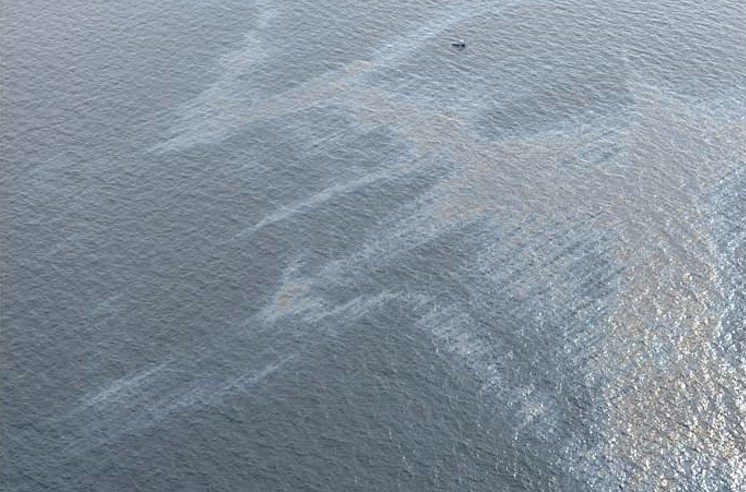Oil slick at the Taylor MC20 site. Credit: U.S Coast Guard
The U.S. Coast Guard has partially assumed federal control over the operation to contain an oil dishcarge from the site of MC20 platform in the U.S. Gulf of Mexico that has likely been leaking since the platform toppled back in 2004.
The platform, owned by Taylor Energy, LLC, was located in Mississippi Canyon Block 20, approximately 11 miles south of the mouth of the Mississippi River. It toppled in September 2004 during Hurricane Ivan after storm surge triggered an underwater mudslide. The incident left the platform well conductor pipes buried in more than 100 feet of mud and sediment, impacting 25 of 28 connected wells. The spill went unnoticed for years until 2008 when it was identified as the source of daily sheen reports.
Now more fourteen years after the hurricane, crude oil continues to discharge from the site and surface on the Gulf waters.
IN 2015, the U.S. Bureau of Safety and Environmental Enforcement estimated that oil continues to leak at a rate of approximately 1 to 55 barrels of oil per day. Satellite imagery and overflights have shown oil slicks on the surface varying in size, sometimes ranging up to 30 miles in length.
Even still, the specific source, or sources of the discharge at the MC20 site are not fully known.
Federal officials have directed Taylor Energy, as the Responsible Party, to remove the platform deck, remove sub-sea debris, decommission the oil pipeline, attempt to contain the leaking oil, and plug nine of the 25 impacted wells that were deemed highest risk.
Following several scientific studies conducted over several years by federal and industrial experts, the Federal On-Scene Coordinator (FOSC) issued Taylor Energy an administrative order back in October requiring it to propose a final viable plan to install a containment system. Last month, however, the FOSC ultimately issued Taylor Energy a Notice of Federal Assumption, and assumed authority for containing the oil.
Under the Federal Water Pollution Control Act, the Coast Guard will now be able to access the Oil Spill Liability Trust Fund and assume authority for containing and disposing the oil.
“While the safety of response personnel is paramount, we don’t want to delay response activities,” said U.S. Coast Guard Capt. Kristi Luttrell, the Federal On-Scene Coordinator (FOSC) for the MC20 response. “We plan to leverage every weather window available from now until the system is installed and collecting oil,” she said.
In November, Coast Guard contracted a specialized team to conduct a comprehensive site survey, fabricate a containment system, and install it at the source to start collecting the oil, however, as of now, the team is still in the planning phase. The Coast Guard says weather and sea state will largely dictate operations, which is expected to involve cumulative weeks at sea, extensive dive and remotely operated vehicle (ROV) operations, and underwater equipment installation.
“We are committed to public safety and preserving the Gulf marine environment,” said Luttrell. “As we move swiftly to develop and install the containment system, we will continue working with our federal, state, and local partners to ensure a permanent solution is in place,” she said.
As the Responsible Party, Taylor Energy, which is now defunct, is required to pay for oil spill recovery and response costs under the Oil Pollution Act of 1990 (OPA). It also has a continuing legal obligation to respond to the ongoing oil discharge and also must comply with the Coast Guard Administrative Orders.

 Join The Club
Join The Club











